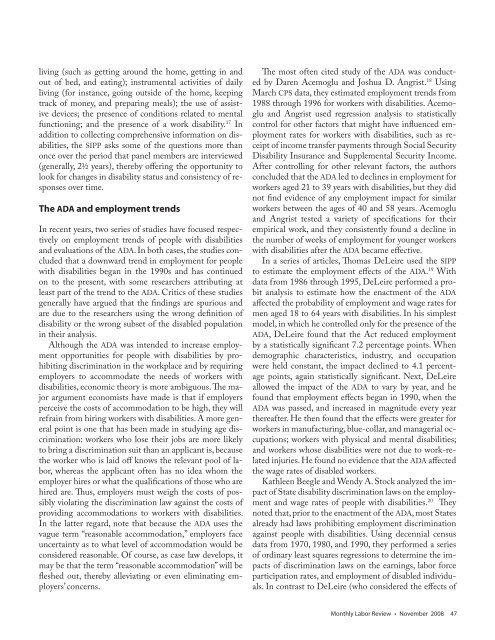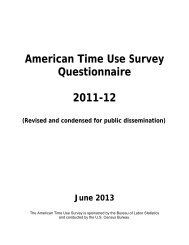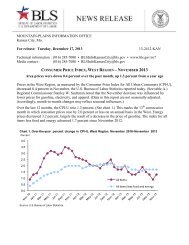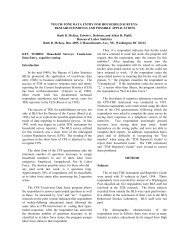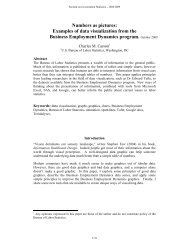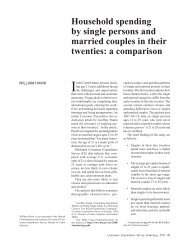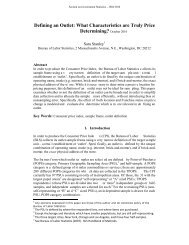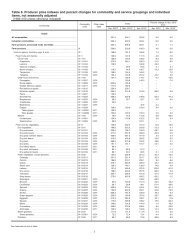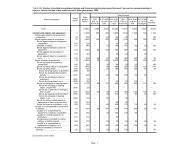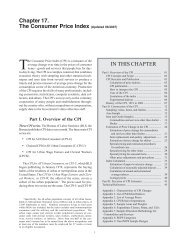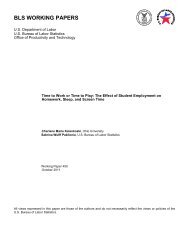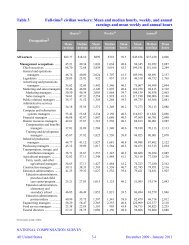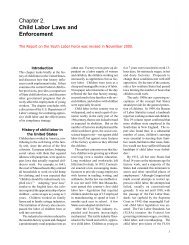The decline of employer stock as a 401(k) investment vehicle
The decline of employer stock as a 401(k) investment vehicle
The decline of employer stock as a 401(k) investment vehicle
You also want an ePaper? Increase the reach of your titles
YUMPU automatically turns print PDFs into web optimized ePapers that Google loves.
living (such <strong>as</strong> getting around the home, getting in and<br />
out <strong>of</strong> bed, and eating); instrumental activities <strong>of</strong> daily<br />
living (for instance, going outside <strong>of</strong> the home, keeping<br />
track <strong>of</strong> money, and preparing meals); the use <strong>of</strong> <strong>as</strong>sistive<br />
devices; the presence <strong>of</strong> conditions related to mental<br />
functioning; and the presence <strong>of</strong> a work disability. 17 In<br />
addition to collecting comprehensive information on disabilities,<br />
the SIPP <strong>as</strong>ks some <strong>of</strong> the questions more than<br />
once over the period that panel members are interviewed<br />
(generally, 2½ years), thereby <strong>of</strong>fering the opportunity to<br />
look for changes in disability status and consistency <strong>of</strong> responses<br />
over time.<br />
<strong>The</strong> ADA and employment trends<br />
In recent years, two series <strong>of</strong> studies have focused respectively<br />
on employment trends <strong>of</strong> people with disabilities<br />
and evaluations <strong>of</strong> the ADA. In both c<strong>as</strong>es, the studies concluded<br />
that a downward trend in employment for people<br />
with disabilities began in the 1990s and h<strong>as</strong> continued<br />
on to the present, with some researchers attributing at<br />
le<strong>as</strong>t part <strong>of</strong> the trend to the ADA. Critics <strong>of</strong> these studies<br />
generally have argued that the findings are spurious and<br />
are due to the researchers using the wrong definition <strong>of</strong><br />
disability or the wrong subset <strong>of</strong> the disabled population<br />
in their analysis.<br />
Although the ADA w<strong>as</strong> intended to incre<strong>as</strong>e employment<br />
opportunities for people with disabilities by prohibiting<br />
discrimination in the workplace and by requiring<br />
<strong>employer</strong>s to accommodate the needs <strong>of</strong> workers with<br />
disabilities, economic theory is more ambiguous. <strong>The</strong> major<br />
argument economists have made is that if <strong>employer</strong>s<br />
perceive the costs <strong>of</strong> accommodation to be high, they will<br />
refrain from hiring workers with disabilities. A more general<br />
point is one that h<strong>as</strong> been made in studying age discrimination:<br />
workers who lose their jobs are more likely<br />
to bring a discrimination suit than an applicant is, because<br />
the worker who is laid <strong>of</strong>f knows the relevant pool <strong>of</strong> labor,<br />
where<strong>as</strong> the applicant <strong>of</strong>ten h<strong>as</strong> no idea whom the<br />
<strong>employer</strong> hires or what the qualifications <strong>of</strong> those who are<br />
hired are. Thus, <strong>employer</strong>s must weigh the costs <strong>of</strong> possibly<br />
violating the discrimination law against the costs <strong>of</strong><br />
providing accommodations to workers with disabilities.<br />
In the latter regard, note that because the ADA uses the<br />
vague term “re<strong>as</strong>onable accommodation,” <strong>employer</strong>s face<br />
uncertainty <strong>as</strong> to what level <strong>of</strong> accommodation would be<br />
considered re<strong>as</strong>onable. Of course, <strong>as</strong> c<strong>as</strong>e law develops, it<br />
may be that the term “re<strong>as</strong>onable accommodation” will be<br />
fleshed out, thereby alleviating or even eliminating <strong>employer</strong>s’<br />
concerns.<br />
<strong>The</strong> most <strong>of</strong>ten cited study <strong>of</strong> the ADA w<strong>as</strong> conducted<br />
by Daren Acemoglu and Joshua D. Angrist. 18 Using<br />
March CPS data, they estimated employment trends from<br />
1988 through 1996 for workers with disabilities. Acemoglu<br />
and Angrist used regression analysis to statistically<br />
control for other factors that might have influenced employment<br />
rates for workers with disabilities, such <strong>as</strong> receipt<br />
<strong>of</strong> income transfer payments through Social Security<br />
Disability Insurance and Supplemental Security Income.<br />
After controlling for other relevant factors, the authors<br />
concluded that the ADA led to <strong>decline</strong>s in employment for<br />
workers aged 21 to 39 years with disabilities, but they did<br />
not find evidence <strong>of</strong> any employment impact for similar<br />
workers between the ages <strong>of</strong> 40 and 58 years. Acemoglu<br />
and Angrist tested a variety <strong>of</strong> specifications for their<br />
empirical work, and they consistently found a <strong>decline</strong> in<br />
the number <strong>of</strong> weeks <strong>of</strong> employment for younger workers<br />
with disabilities after the ADA became effective.<br />
In a series <strong>of</strong> articles, Thom<strong>as</strong> DeLeire used the SIPP<br />
to estimate the employment effects <strong>of</strong> the ADA. 19 With<br />
data from 1986 through 1995, DeLeire performed a probit<br />
analysis to estimate how the enactment <strong>of</strong> the ADA<br />
affected the probability <strong>of</strong> employment and wage rates for<br />
men aged 18 to 64 years with disabilities. In his simplest<br />
model, in which he controlled only for the presence <strong>of</strong> the<br />
ADA, DeLeire found that the Act reduced employment<br />
by a statistically significant 7.2 percentage points. When<br />
demographic characteristics, industry, and occupation<br />
were held constant, the impact <strong>decline</strong>d to 4.1 percentage<br />
points, again statistically significant. Next, DeLeire<br />
allowed the impact <strong>of</strong> the ADA to vary by year, and he<br />
found that employment effects began in 1990, when the<br />
ADA w<strong>as</strong> p<strong>as</strong>sed, and incre<strong>as</strong>ed in magnitude every year<br />
thereafter. He then found that the effects were greater for<br />
workers in manufacturing, blue-collar, and managerial occupations;<br />
workers with physical and mental disabilities;<br />
and workers whose disabilities were not due to work-related<br />
injuries. He found no evidence that the ADA affected<br />
the wage rates <strong>of</strong> disabled workers.<br />
Kathleen Beegle and Wendy A. Stock analyzed the impact<br />
<strong>of</strong> State disability discrimination laws on the employment<br />
and wage rates <strong>of</strong> people with disabilities. 20 <strong>The</strong>y<br />
noted that, prior to the enactment <strong>of</strong> the ADA, most States<br />
already had laws prohibiting employment discrimination<br />
against people with disabilities. Using decennial census<br />
data from 1970, 1980, and 1990, they performed a series<br />
<strong>of</strong> ordinary le<strong>as</strong>t squares regressions to determine the impacts<br />
<strong>of</strong> discrimination laws on the earnings, labor force<br />
participation rates, and employment <strong>of</strong> disabled individuals.<br />
In contr<strong>as</strong>t to DeLeire (who considered the effects <strong>of</strong><br />
Monthly Labor Review • November 2008 47


